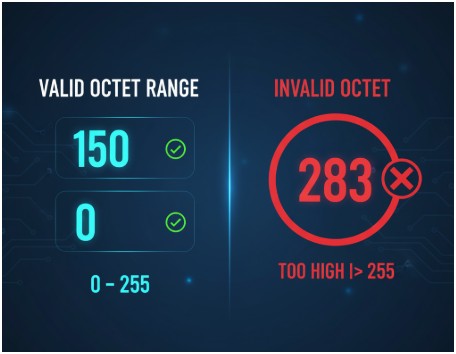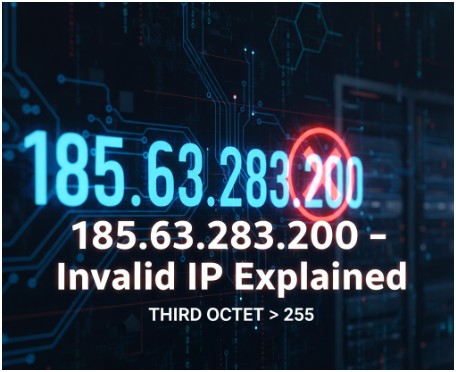I’ll be honest — the first time I typed 185.63.283.200 into a tool, I thought I was being productive. I was troubleshooting a network issue, rushing through my notes, and didn’t think twice about what I’d entered. Then nothing worked. No ping, no trace, no lookup — just errors everywhere.
That’s when I realized something crucial: 185.63.283.200 isn’t even a valid IPv4 address. And that small mistake taught me more about how IP addresses work than hours of reading documentation ever did.
If you’ve ever stared at a number like this and wondered why your tools refuse to cooperate, let’s break it down together.
What Exactly Is 185.63.283.200 Supposed to Be?

At first glance, 185.63.283.200 looks like any other IPv4 address: four numbers separated by dots. But that’s where the illusion ends.
In IPv4, each part (called an octet) can only be a number from 0 to 255. This is because each octet represents 8 bits, and 8 bits can hold a maximum decimal value of 255.
In this example, the third octet is 283 — and that’s the problem.
185 — fine
63 — fine
283 — too large
200 — fine
Because 283 is out of range, the whole thing collapses. It’s like putting a letter in a ZIP code — one wrong character and the entire address becomes meaningless.
Why Is 185.63.283.200 Invalid?

Let’s dive a little deeper. IPv4 addresses are structured like this:
- 4 octets separated by dots
- Each octet: a number between 0 and 255
- Total range: 0.0.0.0 to 255.255.255.255
Each part represents a block of addresses on a network. Devices use these addresses to talk to each other, but they all follow the same basic rule: no octet can exceed 255.
That’s why 185.63.283.200 doesn’t work. The 283 breaks the fundamental rule of the IPv4 system. It’s like giving someone a phone number with 12 digits — the network just doesn’t know how to read it.
How I Realized It Was an Octet Error
Here’s the thing — errors like this are incredibly common, even among experienced network pros. I typed 185.63.283.200 quickly without double-checking, assuming everything was correct. When my pings failed, I assumed the server was down. I wasted time troubleshooting something that wasn’t even real.
It wasn’t until I slowed down and checked the format that I spotted the mistake. That single 283 was the culprit. Once I corrected it to 185.63.23.200, everything started working again.
The takeaway? Always verify each octet before assuming a deeper problem. Typos and out-of-range numbers are more common than you think.
What Happens When You Use an Invalid IP Like 185.63.283.200?
When you try to use an address like 185.63.283.200, your device doesn’t “guess” or try to fix it. It just rejects it outright.
Here’s what typically happens:
- Ping fails: You’ll get an error like “unknown host” or “invalid argument.”
- DNS tools break: Reverse lookups won’t work because the IP doesn’t exist.
- Network scripts crash: Automated tools that expect valid inputs might throw exceptions.
- No routing occurs: Routers simply ignore invalid addresses and drop the packets.
In other words, the system doesn’t try to be clever — it stops right there. That’s why identifying the mistake early saves so much time.
Common Reasons People End Up With Invalid IPs
I’m not the only one who’s made this mistake. In fact, it’s one of the most frequent causes of confusion when dealing with networks. Here are a few reasons you might see something like 185.63.283.200 pop up:
1. Typographical Errors
This is the most obvious. Maybe you meant 185.63.238.200 but swapped two digits. Typos happen, and they’re easy to miss in a long list of IPs.
2. Misconfigured Scripts
If you’re pulling IPs from a database or generating them dynamically, bad data can creep in — especially if validation checks aren’t in place.
3. Copy-Paste Mistakes
Grabbing IPs from different tools or spreadsheets often leads to accidental spaces, mixed-up values, or corrupted data.
4. Misunderstanding the Format
Some beginners assume they can use any number. I’ve seen “300” or even “1000” in octets — a clear sign the basics weren’t fully understood.
How to Spot and Fix Invalid IP Addresses Quickly
Catching errors like 185.63.283.200 early can save you a ton of time. Here’s what I do now to avoid repeating that mistake:
Double-Check Each Octet
Scan through each number and make sure they’re all between 0 and 255. Anything beyond that is a red flag.
Use IP Validation Tools
There are countless free online validators that instantly tell you if an IP is invalid — handy for quick troubleshooting.
Automate Format Checks in Scripts
If you’re coding, add a simple regex or logic check to catch out-of-range values before they cause errors.
Slow Down and Read Carefully
It sounds obvious, but taking an extra 10 seconds to review your input can prevent hours of wasted troubleshooting.
IPv4 vs. IPv6: Why This Problem Exists Mostly With IPv4
This whole issue is specific to IPv4, the older version of the Internet Protocol. IPv6, which uses hexadecimal and a completely different structure, doesn’t have the same “255 limit” problem.
However, IPv4 is still everywhere — from routers and servers to IoT devices — so understanding how it works is essential.
As long as IPv4 is around (and it will be for decades), knowing why something like 185.63.283.200 is invalid will remain a core troubleshooting skill.
FAQs About 185.63.283.200 and IP Formatting
Why is 185.63.283.200 considered invalid?
Because the third octet is 283, which is outside the allowed range of 0 to 255. Any octet beyond 255 instantly makes an IPv4 address invalid.
Can I fix 185.63.283.200 and make it valid?
Yes — but you’d need to replace 283 with a number between 0 and 255. For example, 185.63.23.200 would be valid.
What tools can help me validate IP addresses?
Online validators like IPVoid, WhatIsMyIP, or built-in commands like ping, nslookup, and traceroute can help you spot formatting errors quickly.
What’s the difference between invalid and unreachable IPs?
Invalid IPs (like 185.63.283.200) don’t exist because they break the format rules. Unreachable IPs are correctly formatted but not responding — often due to firewalls or offline devices.
Wrapping It Up: What 185.63.283.200 Taught Me
Here’s the lesson I took away from my little mistake: the details matter. One small digit out of place — like the “283” in 185.63.283.200 — can grind an entire network task to a halt.
It’s not just about numbers; it’s about structure, precision, and understanding how systems read data.
The next time you’re troubleshooting and nothing seems to work, take a step back and check the basics. More often than not, the problem isn’t the network — it’s a small mistake like this one hiding in plain sight.

